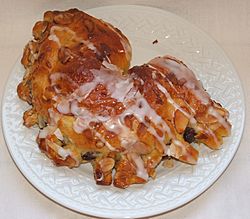Bear claw facts for kids
 |
|
| Type | Pastry, doughnut or fritter |
|---|---|
| Place of origin | United States |
| Main ingredients | Dough, almond paste |
| Ingredients generally used | Raisins |
A bear claw is a yummy, sweet pastry. It's made with yeast, which helps the dough rise and become fluffy. It's a type of Danish, which are pastries often enjoyed for breakfast or as a treat. This pastry first appeared in the United States around 1914.
In Denmark, a similar pastry is called kamme. France also has its own version, called patte d'ours, which means bear paw. This French version was created in 1982. The name "bear claw" was first used for this pastry in March 1914 by a bakery in Sacramento, California. People in the western parts of the U.S. often use the name "bear claw" for this pastry.
What is a Bear Claw?
Most Danish pastries use similar basic ingredients. These include eggs, yeast, flour, milk, sugar, and butter. A bear claw is also made with a special "sweet dough." This dough is like bread dough but has more shortening, which makes it richer.
How it Looks and Tastes
One big difference between bear claws and other Danish pastries is their shape. A bear claw is usually filled with a sweet almond paste. Sometimes, it also has raisins inside.
The pastry is often shaped like a half-circle. It has small cuts along its curved edge. As the dough bakes and rises, these cuts separate. This makes the pastry look like a bear's toes, which is how it got its name!
Sometimes, a bear claw can also be a type of yeast doughnut. These doughnuts are shaped similarly to the pastry. They might have fillings like apple pie filling, butter pecan, dates, cream cheese, grape, or cherry.
How Bear Claws are Made
You can make a bear claw by hand or with a machine. A special tool called a bear claw cutter was invented in 1950 to help make them by hand.
In 1948, a patent described how to put a bear claw together. First, the dough is rolled out flat. Then, the sweet filling is spread over it. The dough is folded over the filling. Next, small cuts are made to create the "claw" look. Finally, the dough is cut into individual pastries. The pastry can then be curved into a half-circle, which helps the "toes" separate even more when it bakes.
See also
 In Spanish: Bear claw para niños
In Spanish: Bear claw para niños

